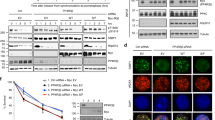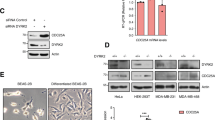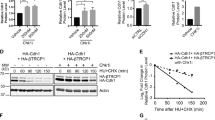Abstract
The phosphatidylinositol-3-kinase-like kinase ATM (ataxia-telangiectasia mutated) has a central role in coordinating DNA damage responses, including cell-cycle checkpoint control, DNA repair and apoptosis. Mutations of ATM cause a spectrum of defects ranging from neurodegeneration to cancer predisposition. However, the mechanism by which DNA damage activates ATM is poorly understood. Here we show that Cdk5 (cyclin-dependent kinase 5), activated by DNA damage, directly phosphorylates ATM at Ser 794 in post-mitotic neurons. Phosphorylation at Ser 794 precedes, and is required for, ATM autophosphorylation at Ser 1981, and activates ATM kinase activity. The Cdk5–ATM signal regulates phosphorylation and function of the ATM targets p53 and H2AX. Interruption of the Cdk5–ATM pathway attenuates DNA-damage-induced neuronal cell cycle re-entry and expression of the p53 targets PUMA and Bax, protecting neurons from death. Thus, activation of Cdk5 by DNA damage serves as a critical signal to initiate the ATM response and regulate ATM-dependent cellular processes.
This is a preview of subscription content, access via your institution
Access options
Subscribe to this journal
Receive 12 print issues and online access
$209.00 per year
only $17.42 per issue
Buy this article
- Purchase on Springer Link
- Instant access to full article PDF
Prices may be subject to local taxes which are calculated during checkout





Similar content being viewed by others
References
McKinnon, P. J. ATM and ataxia telangiectasia. EMBO Rep. 5, 772–776 (2004).
Khanna, K. K., Lavin, M. F., Jackson, S. P. & Mulhern, T. D. ATM, a central controller of cellular responses to DNA damage. Cell Death Differ. 8, 1052–1065 (2001).
Roos, W. P. & Kaina, B. DNA damage-induced cell death by apoptosis. Trends Mol. Med. 12, 440–450 (2006).
Bakkenist, C. J. & Kastan, M. B. DNA damage activates ATM through intermolecular autophosphorylation and dimer dissociation. Nature 421, 499–506 (2003).
Kozlov, S. V. et al. Involvement of novel autophosphorylation sites in ATM activation. EMBO J. 25, 3504–3514 (2006).
Dupre, A., Boyer-Chatenet, L. & Gautier, J. Two-step activation of ATM by DNA and the Mre11-Rad50-Nbs1 complex. Nature Struct. Mol. Biol. 13, 451–457 (2006).
Pellegrini, M. et al. Autophosphorylation at serine 1987 is dispensable for murine Atm activation in vivo. Nature 443, 222–225 (2006).
Park, D. S., Levine, B., Ferrari, G. & Greene, L. A. Cyclin dependent kinase inhibitors and dominant negative cyclin dependent kinase 4 and 6 promote survival of NGF-deprived sympathetic neurons. J. Neurosci. 17, 8975–8983 (1997).
Liu, D. X. & Greene, L. A. Neuronal apoptosis at the G1/S cell cycle checkpoint. Cell Tissue Res. 305, 217–228 (2001).
Park, D. S. et al. Cyclin-dependent kinases participate in death of neurons evoked by DNA-damaging agents. J. Cell Biol. 143, 457–467 (1998).
Copani, A. et al. Activation of cell-cycle-associated proteins in neuronal death: a mandatory or dispensable path? Trends Neurosci. 24, 25–31 (2001).
Herrup, K., Neve, R., Ackerman, S. L. & Copani, A. Divide and die: cell cycle events as triggers of nerve cell death. J. Neurosci. 24, 9232–9239 (2004).
Herzog, K. H., Chong, M. J., Kapsetaki, M., Morgan, J. I. & McKinnon, P. J. Requirement for Atm in ionizing radiation-induced cell death in the developing central nervous system. Science 280, 1089–1091 (1998).
Lee, Y., Chong, M. J. & McKinnon, P. J. Ataxia telangiectasia mutated-dependent apoptosis after genotoxic stress in the developing nervous system is determined by cellular differentiation status. J. Neurosci. 21, 6687–6693 (2001).
Kruman, II et al. Cell cycle activation linked to neuronal cell death initiated by DNA damage. Neuron 41, 549–561 (2004).
Dhavan, R. & Tsai, L. H. A decade of CDK5. Nature Rev. Mol. Cell Biol. 2, 749–759 (2001).
Tang, X. et al. Cyclin-dependent kinase 5 mediates neurotoxin-induced degradation of the transcription factor myocyte enhancer factor 2. J. Neurosci. 25, 4823–4834 (2005).
Gong, X. et al. Cdk5-mediated inhibition of the protective effects of transcription factor MEF2 in neurotoxicity-induced apoptosis. Neuron 38, 33–46 (2003).
Wu, J. & Liu, L. F. Processing of topoisomerase I cleavable complexes into DNA damage by transcription. Nucleic Acids Res. 25, 4181–4186 (1997).
Xiao, H. et al. The topoisomerase IIbeta circular clamp arrests transcription and signals a 26S proteasome pathway. Proc. Natl Acad. Sci. USA 100, 3239–3244 (2003).
Pommier, Y. Topoisomerase I inhibitors: camptothecins and beyond. Nature Rev. Cancer 6, 789–802 (2006).
Sedarous, M. et al. Calpains mediate p53 activation and neuronal death evoked by DNA damage. J. Biol. Chem. 278, 26031–26038 (2003).
Lee, M. S. et al. Neurotoxicity induces cleavage of p35 to p25 by calpain. Nature 405, 360–364 (2000).
Li, B. S., Zhang, L., Gu, J., Amin, N. D. & Pant, H. C. Integrin α(1) β(1)-mediated activation of cyclin-dependent kinase 5 activity is involved in neurite outgrowth and human neurofilament protein H Lys-Ser-Pro tail domain phosphorylation. J. Neurosci. 20, 6055–6062 (2000).
Rozan, L. M. & El-Deiry, W. S. p53 downstream target genes and tumor suppression: a classical view in evolution. Cell Death Differ. 14, 3–9 (2007).
Hickson, I. et al. Identification and characterization of a novel and specific inhibitor of the ataxia-telangiectasia mutated kinase ATM. Cancer Res. 64, 9152–9159 (2004).
Gupta, A. et al. Involvement of human MOF in ATM function. Mol. Cell Biol. 25, 5292–5305 (2005).
Sun, Y., Jiang, X., Chen, S., Fernandes, N. & Price, B. D. A role for the Tip60 histone acetyltransferase in the acetylation and activation of ATM. Proc. Natl Acad. Sci. USA 102, 13182–13187 (2005).
Uziel, T. et al. Requirement of the MRN complex for ATM activation by DNA damage. EMBO J. 22, 5612–5621 (2003).
Kitagawa, R., Bakkenist, C. J., McKinnon, P. J. & Kastan, M. B. Phosphorylation of SMC1 is a critical downstream event in the ATM–NBS1–BRCA1 pathway. Genes Dev. 18, 1423–1438 (2004).
Falck, J., Coates, J. & Jackson, S. P. Conserved modes of recruitment of ATM, ATR and DNA-PKcs to sites of DNA damage. Nature 434, 605–611 (2005).
Jamsa, A., Hasslund, K., Cowburn, R. F., Backstrom, A. & Vasange, M. The retinoic acid and brain-derived neurotrophic factor differentiated SH-SY5Y cell line as a model for Alzheimer's disease-like tau phosphorylation. Biochem. Biophys. Res. Commun. 319, 993–1000 (2004).
Khanna, K. K. et al. ATM associates with and phosphorylates p53: mapping the region of interaction. Nature Genet. 20, 398–400 (1998).
Lim, D. S. et al. ATM binds to β-adaptin in cytoplasmic vesicles. Proc. Natl Acad. Sci. USA 95, 10146–10151 (1998).
Meuer, K. et al. Cyclin-dependent kinase 5 is an upstream regulator of mitochondrial fission during neuronal apoptosis. Cell Death Differ. 14, 651–661 (2007).
Lois, C., Hong, E. J., Pease, S., Brown, E. J. & Baltimore, D. Germline transmission and tissue-specific expression of transgenes delivered by lentiviral vectors. Science 295, 868–872 (2002).
el-Deiry, W. S. et al. WAF1, a potential mediator of p53 tumor suppression. Cell 75, 817–825 (1993).
Acknowledgements
We thank Bert Vogelstein, Richard Gatti, Michael Kastan, Martin Lavin and Shuki Mizutani for p53 reporter constructs, purified ATM protein, ATM mammalian expression constructs, GST–ATM expression constructs, and A-T cell lines, respectively. This work was partially supported by NIH grants R01 NS048254 (Z. M.) and R01 AG023695 (Z. M.) and The Robert W. Woodruff Health Sciences Center Fund (Z. M.).
Author information
Authors and Affiliations
Contributions
Z.M. coordinated the overall project and planned the original experimental design; B.T. and Q.Y. conducted the experiments; Z.M. and B.T. analysed the data and wrote the paper.
Corresponding author
Ethics declarations
Competing interests
The authors declare no competing financial interests.
Supplementary information
Supplementary Information
Supplementary Information (PDF 954 kb)
Rights and permissions
About this article
Cite this article
Tian, B., Yang, Q. & Mao, Z. Phosphorylation of ATM by Cdk5 mediates DNA damage signalling and regulates neuronal death. Nat Cell Biol 11, 211–218 (2009). https://doi.org/10.1038/ncb1829
Received:
Accepted:
Published:
Issue Date:
DOI: https://doi.org/10.1038/ncb1829
This article is cited by
-
Protein post-translational modifications in the regulation of cancer hallmarks
Cancer Gene Therapy (2023)
-
Sting and p53 DNA repair pathways are compromised in Alzheimer’s disease
Scientific Reports (2023)
-
Multimodal perturbation analyses of cyclin-dependent kinases reveal a network of synthetic lethalities associated with cell-cycle regulation and transcriptional regulation
Scientific Reports (2023)
-
Unveiling Potential Neurotoxic Mechansisms: Pb-Induced Activation of CDK5-p25 Signaling Axis in Alzheimer’s Disease Development, Emphasizing CDK5 Inhibition and Formation of Toxic p25 Species
Molecular Neurobiology (2023)
-
Failure of DNA double-strand break repair by tau mediates Alzheimer’s disease pathology in vitro
Communications Biology (2022)



